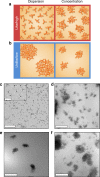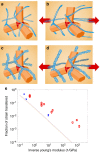Microscopic mechanisms of deformation transfer in high dynamic range branched nanoparticle deformation sensors
- PMID: 29559619
- PMCID: PMC5861061
- DOI: 10.1038/s41467-018-03396-5
Microscopic mechanisms of deformation transfer in high dynamic range branched nanoparticle deformation sensors
Abstract
Nanoscale stress sensing is of crucial importance to biomechanics and other fields. An ideal stress sensor would have a large dynamic range to function in a variety of materials spanning orders of magnitude of local stresses. Here we show that tetrapod quantum dots (tQDs) exhibit excellent sensing versatility with stress-correlated signatures in a multitude of polymers. We further show that tQDs exhibit pressure coefficients, which increase with decreasing polymer stiffness, and vary >3 orders of magnitude. This high dynamic range allows tQDs to sense in matrices spanning >4 orders of magnitude in Young's modulus, ranging from compliant biological levels (~100 kPa) to stiffer structural polymers (~5 GPa). We use ligand exchange to tune filler-matrix interfaces, revealing that inverse sensor response scaling is maintained upon significant changes to polymer-tQD interface chemistry. We quantify and explore mechanisms of polymer-tQD strain transfer. An analytical model based on Mori-Tanaka theory presents agreement with observed trends.
Conflict of interest statement
The authors declare no competing interests.
Figures





References
-
- Shiari B, Miller RE. Multiscale modeling of crack initiation and propagation at the nanoscale. J. Mech. Phys. Solids. 2016;88:35–49. doi: 10.1016/j.jmps.2015.12.003. - DOI
Publication types
LinkOut - more resources
Full Text Sources
Other Literature Sources

